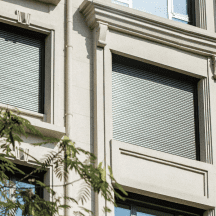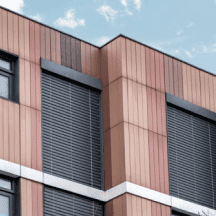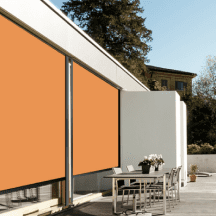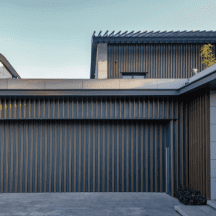MEDIA CENTER
Mar 29th, 2025
Guidelines for Selecting External Sunshade Products in Different Climate Zones
In architectural design, external sunshades are not just functional tools but a medium for dialogue between buildings and climate. From the humid heat of tropical rainforests to the scorching sandstorms of deserts, varying sunlight, temperature, humidity, and wind patterns across climate zones shape distinct sunshade requirements. This guide analyzes the suitability of three mainstream products—aluminum roller shades, aluminum louvers, and ZIP fabric roller shades—in typical global climate zones, equipping buildings with sunshades that truly “understand” their environment.
Humid and Hot Climate Zones (e.g., Southeast Asia, Southern China)
Climate Features: Annual humidity >75%, solar radiation intensity up to 1,200 W/m², frequent rainfall, and monsoon winds.
Selection Strategy:
In humid environments, sunshades must act like “breathing skin”—blocking harsh sunlight while promoting airflow. Aluminum louvers excel with their adjustability:
25°–40° blade tilt blocks 60% of direct sunlight while channeling monsoon winds to reduce indoor humidity.
Perforated blades (3–5 mm apertures) boost ventilation by 30% without rainwater ingress.
Anodized surfaces resist salt corrosion, extending lifespan by 30% in coastal areas.
Case Study: Singapore’s Marina Bay residences use dual-layer aluminum louvers—outer perforated blades for airflow and inner adjustable blades for light control—achieving a 28% annual reduction in cooling energy.
Dry and Hot Climate Zones (e.g., Middle East, North Africa)
Climate Features: Annual sunshine >3,000 hours, daily temperature swings up to 25°C, frequent sandstorms.
Selection Strategy:
Here, sunshades must serve as “light shields.” Aluminum roller shades dominate with absolute solar defense:
Nano-reflective coatings reflect 95% of solar radiation, keeping surfaces 8–12°C cooler than ambient air.
Full closure creates continuous shade, stabilizing indoor temperatures within 3°C fluctuations when paired with thermal mass walls.
Nighttime retraction enables passive cooling via natural airflow.
Innovation: A Dubai office tower’s solar-integrated roller shades convert blocked sunlight into electricity, meeting 60% of the system’s energy needs.
Cold Climate Zones (e.g., Scandinavia, Canada)
Climate Features: Winter solar angles <15°, annual snow cover >120 days, heating-dominated demand.
Selection Strategy:
Sunshades must toggle between winter and summer roles. Aluminum louvers achieve dual functionality:
Vertical blades in winter admit 60% of low-angle sunlight, harvesting 2.3 kWh/m² daily.
15° tilt in summer blocks 80% of direct light, while inert gas-filled hollow blades reduce heat transfer by 30%.
Snow-load-resistant designs prevent deformation, with hinges operational at -30°C.
Case Study: Tromsø Library (Norway) links louvers to geothermal systems, storing summer heat in underground reservoirs for winter reuse.
Temperate Climate Zones (e.g., Mediterranean, Eastern China)
Climate Features: Distinct seasons, 40° solar angle variations, occasional extreme weather.
Selection Strategy:
Adaptability is key. ZIP fabric roller shades shine with flexibility:
5%–40% adjustable translucency accommodates soft spring light or harsh summer glare.
Dual-layer weave reflects UV rays while diffusing light, eliminating indoor glare.
5-second deployment responds to sudden storms, with tear resistance up to 800 N/5 cm.
Smart Upgrade: A Shanghai office’s AI-powered fabric shades sync with weather APIs, auto-adjusting 3 hours ahead, reducing manual intervention by 90%.
Extreme Climate Zones (Deserts/Polar Regions)
Challenges: Desert winds >15 m/s, polar temperatures down to -50°C.
Custom Solutions:
Desert-grade aluminum roller shades:
Sand-filtering tracks block particulate ingress.
Micron-level anti-stick coatings shed 98% of sand.
Polar-enhanced aluminum louvers:
Aerogel-filled blades (thermal conductivity: 0.018 W/(m·K)).
Hydraulic actuators maintain 80% efficiency in extreme cold.
Field Data: A Sahara test building’s reinforced shades retained 98% operability after 30 days of sandstorms.
Three Golden Rules for Selection
Energy Balance Principle:
Annual energy savings must exceed 5× the product’s lifecycle carbon footprint (per LEED standards).
Climate Resilience Principle:
Durability should surpass local extreme climate parameters by 20% (e.g., century-level winds/temperatures).
Cultural Harmony Principle:
Designs should reflect regional aesthetics (e.g., geometric Middle Eastern louvers, minimalist Nordic fabrics).
When Tokyo Skytree’s aluminum louvers adjust translucency for cherry blossom season, or Dubai’s Museum of the Future syncs its shades with desert light, sunshades transcend function to become architecture’s poetic response to climate. Choosing the right product embeds a building with its climatic DNA—allowing it to harmonize with sunlight, wind, and seasonal rhythms, breathing in sync with the planet.
Contact us

Kevin
Account Manager

info@ulepanda.com

+86 18551587339

+86 18551587339







